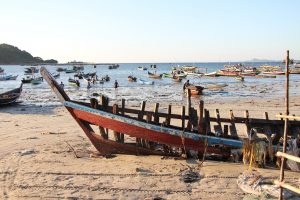Myanmar’s enforcement agencies operate in a complex security environment. Several armed groups struggle for greater autonomy, ethnic violence has resulted in massive population displacement, and the synthetic drug trade has flourished. The destabilizing effects of Myanmar’s land-based conflicts have begun to impact waterways. On October 26, members of the Arakan Army (AA) insurgent group based in Rakhine state raided a ferry to take police officers and soldiers hostage. Although the attack occurred on a river, the incident demonstrates the AA’s growing capacity and interest in water-based operations.
A dedicated coast guard will mitigate the maritime domain’s vulnerability to exploitation by land-based illicit actors. By instituting a coast guard, Myanmar will increase coastal security without detracting from the conventional, blue-water warfighting capabilities of its newly modernized navy. In the works since March 2019, a coast guard in Myanmar will offer technical skill sets, closer relationships with civilian agencies, and enhanced interoperability with land-based forces.
The emphasis on technical skill sets and relationship-building improves the coast guard’s efficiency and effectiveness in dealing with illicit actors. Detailed knowledge on crime scene investigation techniques, gathering evidence for fishing violations, and search patterns for lost vessels provides coast guard personnel with the training needed to contend with civilian perpetrators of maritime crime. The specialized training optimizes resource allocation as coast guard vessels can often more rapidly identify and apprehend illicit actors. This leaves the army free to concentrate on training manpower in areas like contending with peer adversaries in conventional warfighting scenarios.
The closer ties cultivated by coast guards with civilian agencies, like fisheries management, port authorities, and maritime police, provide opportunities for sharing information and building trust. The resulting increase in maritime domain awareness (MDA) hampers the ability of illicit coastal actors to exploit Myanmar’s extensive coast, which includes 23,070 square kilometers of territorial waters. Working off information on trading routes and fishing zones gathered from civilian organizations, coast guard vessels can better identify and track the movements of artisanal fishing boats. Coast guard patrols, armed with this information, can help fill a gap in MDA, as Myanmar’s coastal radar system has difficulty detecting smaller vessels and has limited range. The coast guard’s closer relationship to civilian agencies helps agencies with overlapping jurisdictions work together.
The sustained nature of violence in Myanmar’s coastal states has forced water- and land-based forces to collaborate, especially through joint counterinsurgency operations in Rakhine state, Tanintharyi region, and the Irrawaddy delta. The porous border between the land and the sea creates the opportunity for smugglers, traffickers, and insurgents to resupply and reinforce their land-based operations. Dialogue with army intelligence units on topics like inland drug-trade routes and insurgency areas of operation addresses this interconnected nature of maritime and coastal crime. Maritime enforcement efforts, however, have nominally been subordinate to land-based operations of the army, which number roughly 375,000 compared to the navy’s 16,000. As highlighted in the Stable Seas: Bay of Bengal maritime security report, this asymmetrical approach to enforcement detracts from a country’s ability to comprehensively address security challenges.
Myanmar plans to also create a unified command center alongside the coast guard, staffed by experts from the Maritime Police Force, Immigration Department, Customs Department, Marine Administration Department, and the Myanmar Port Authority. Including land-based stakeholders and military officials in their meetings will facilitate understanding of how the maritime domain affects coastal security. By using the command center as a medium to convey information between land- and water-based agencies, a holistic strategy can be developed to contend with illicit coastal actors who move fluidly between domains.
As nonstate actors like the Arakan Army increasingly contest government control of coastal waters, it is imperative that Myanmar focus on coastal security. The specialized abilities of the coast guard build on the lessons learned from the Sri Lankan counterinsurgency operations against the Tamil Sea Tigers, where focusing on nontraditional maritime security threats helped turn the tide of war. By similarly acknowledging the important role played by the maritime domain in supporting coastal stability, Myanmar can counteract the emerging threat. The coast guard and its associated command center can address law enforcement shortcomings by capitalizing on their civilian ties and collaborating with land-based military units. Working alongside the navy, the coast guard can significantly improve overall maritime stability in territorial waters.
Michael van Ginkel has a master’s degree in conflict studies and conducts work for the Stable Seas program, which focuses on maritime security and governance.

































